Jacopo Zucchi (circa 1541–1590) stands as a significant, if sometimes overlooked, figure in the vibrant tapestry of late Italian Renaissance art, specifically within the sophisticated and often intellectually charged movement known as Mannerism. Born in Florence, the cradle of the Renaissance, Zucchi absorbed the artistic innovations of his predecessors and contemporaries, forging a distinctive style characterized by decorative elegance, intricate compositions, and a penchant for mythological and allegorical subjects. His career, which began in the bustling workshops of Florence and culminated in the prestigious artistic circles of Rome, reflects the shifting cultural and patronage landscapes of sixteenth-century Italy. This exploration will delve into his life, artistic development, major works, collaborations, and enduring legacy.
Early Life and Florentine Foundations
Jacopo Zucchi, or Jacopo di Maestro Piero Zucca as he was sometimes recorded, was born in Florence around 1541. His early artistic training commenced under the tutelage of the eminent painter, architect, and art historian Giorgio Vasari. Vasari, a towering figure of the period, was not only a prolific artist but also the mastermind behind large-scale decorative projects for the Medici dukes and the author of the seminal "Lives of the Most Excellent Painters, Sculptors, and Architects." Working in Vasari's highly organized and productive workshop provided Zucchi with invaluable experience in a wide range of artistic endeavors, from panel painting to fresco decoration and the design of ephemeral apparatus for courtly festivities.
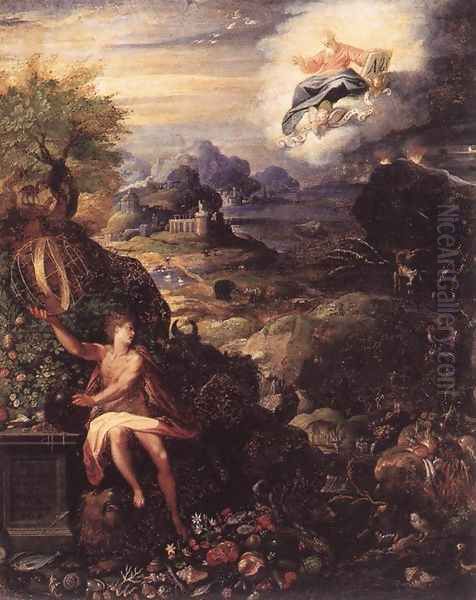
During his formative years in Florence, Zucchi became a trusted assistant to Vasari. He actively participated in several of Vasari's most ambitious undertakings, most notably the extensive redecoration of the Palazzo Vecchio, the civic heart of Florence. Within this grand ducal palace, Zucchi contributed to various schemes, including the Studiolo of Francesco I de' Medici, a small, jewel-like chamber designed to house the Duke's collection of rare and precious objects. While Vasari and his humanist advisor Vincenzo Borghini conceived the complex iconographic program, artists like Zucchi, Giovanni Stradano (Jan van der Straet), and Giovanni Battista Naldini were responsible for executing the exquisite panel paintings that adorned its walls and ceiling. Zucchi's contributions, such as "The Discovery of Glass" and "The Mine," demonstrate his early facility with elegant figural representation and detailed rendering, hallmarks of the sophisticated Mannerist style favored by the Medici court.
His involvement with the Accademia del Disegno (Academy of Design), founded by Vasari in 1563, further immersed him in the artistic and intellectual currents of Florence. This institution aimed to elevate the status of artists and promote artistic education. Zucchi's participation in projects like the elaborate funeral decorations for Michelangelo Buonarroti in 1564, organized by the Accademia, showcased his skills and connected him with the leading artists of the city. These early experiences in Florence were crucial in shaping his technical proficiency and his understanding of complex allegorical programs, preparing him for the next significant phase of his career.
The Transition to Rome and Medici Patronage
Around 1572, Jacopo Zucchi made a pivotal move from Florence to Rome. This relocation was largely facilitated by his continued association with the powerful Medici family. Cardinal Ferdinando de' Medici, who would later become Grand Duke of Tuscany, became Zucchi's most important patron in Rome. Ferdinando was a discerning collector and a significant figure in the cultural life of the Eternal City, and he entrusted Zucchi with numerous commissions, primarily for the decoration of his lavish residences.
One of Zucchi's earliest and most significant Roman projects for Cardinal Ferdinando was the decoration of a studiolo or private study within the Palazzo Firenze. Though less famous than Francesco I's Florentine Studiolo, this Roman counterpart was similarly intended as an intimate space for intellectual pursuits and the display of precious items. Zucchi's work here, though not fully preserved, further honed his skills in creating intricate decorative ensembles that blended painting, stucco, and gilding.
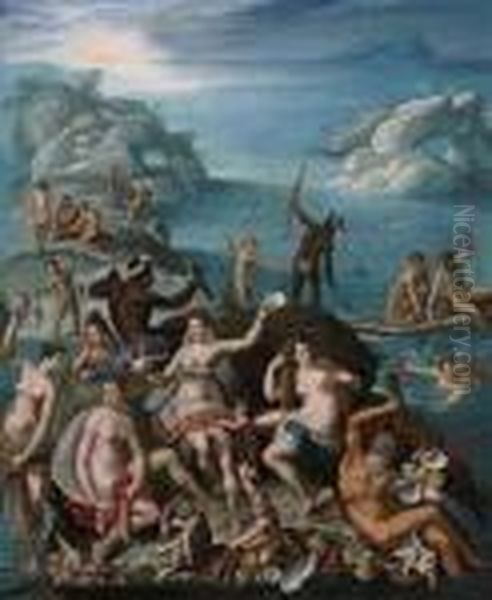
His services to Cardinal Ferdinando extended to the Villa Medici on the Pincian Hill, a magnificent suburban retreat that the Cardinal was transforming into a veritable museum of classical antiquities and contemporary art. Zucchi was involved in various decorative aspects of the villa, contributing to its opulent and learned atmosphere. His ability to work within complex iconographic frameworks, often laden with classical allusions and neoplatonic ideas, made him an ideal artist for such sophisticated patrons. The Roman environment, with its overwhelming presence of classical ruins and High Renaissance masterpieces by artists like Raphael and Michelangelo, undoubtedly had a profound impact on Zucchi's artistic vision, encouraging a continued engagement with classical forms while retaining his Mannerist sensibilities.
Artistic Style: The Essence of Mannerism
Jacopo Zucchi's style is quintessentially Mannerist, reflecting the movement's departure from the harmonious balance and naturalism of the High Renaissance towards a more artificial, elegant, and intellectually complex aesthetic. His figures are often characterized by elongated proportions, graceful S-shaped curves (the figura serpentinata), and stylized poses that prioritize elegance and artifice over strict anatomical accuracy. This was a common trait shared with other Mannerists like Agnolo Bronzino, Francesco Salviati, and Parmigianino, who sought a refined and sophisticated beauty.
Zucchi's compositions are typically crowded and dynamic, filled with numerous figures arranged in complex, often swirling, patterns. He demonstrated a remarkable skill in handling intricate narratives and allegories, packing his canvases with symbolic details that would have been deciphered and appreciated by his educated patrons. His color palette is often rich and vibrant, employing jewel-like tones and sometimes unexpected juxtapositions that enhance the decorative quality of his work. There's a polished, almost enameled finish to many of his panel paintings, particularly his smaller cabinet pictures, which were highly prized by collectors.
A notable characteristic of Zucchi's art is its strong decorative impulse. His paintings, whether large-scale frescoes or intimate works on copper, often feature an abundance of ornamental details, including elaborate costumes, intricate jewelry, and lush landscapes or architectural settings. This decorative richness is sometimes attributed to an influence from Northern European art, particularly the detailed naturalism of Flemish painters, which was increasingly appreciated in Italy during this period. Artists like Bartholomeus Spranger, though a contemporary working further north, shared a similar taste for elegant eroticism and complex allegory that resonated with late Mannerist trends. Zucchi's work, however, remains firmly rooted in the Italian tradition, particularly the Florentine emphasis on disegno (drawing and design).
His handling of light and shadow contributes to the drama and visual appeal of his scenes. While not as overtly dramatic as the later chiaroscuro of Caravaggio, Zucchi employed strong contrasts, with bright highlights accentuating the smooth, porcelain-like skin of his figures against darker, more mysterious backgrounds. This technique enhanced the three-dimensionality of his forms and added a sense of theatricality to his compositions.
Major Works and Thematic Concerns
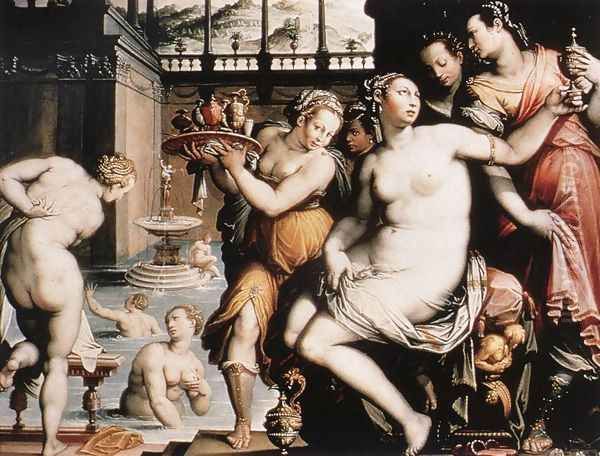
Jacopo Zucchi's oeuvre encompasses a range of subjects, with a particular emphasis on mythological narratives, allegories, and, to a lesser extent, religious themes. His works often explore complex ideas about love, creation, the ages of humanity, and the power of the gods.
Mythological Masterpieces
Mythology provided Zucchi with fertile ground for his imaginative compositions and elegant figures. One of his most celebrated works is "Amor and Psyche" (circa 1589), now in the Galleria Borghese, Rome. This painting, likely executed for the Capponi family, depicts the climactic moment from Apuleius's "Metamorphoses" where Psyche, holding a lamp, gazes upon the sleeping god Cupid, violating his command. Zucchi masterfully captures the intimacy and tension of the scene, with Psyche's delicate beauty and Cupid's idealized form rendered with exquisite refinement. The composition is filled with symbolic details, such as the discarded arrows and the opulent bedchamber, all contributing to the painting's rich narrative and sensual appeal. The smooth, polished surfaces and jewel-like colors are characteristic of his late style.
Another significant mythological series includes "The Golden Age" and "The Silver Age," frescoes that once adorned a Roman palace and are now known through various versions and studies, with notable examples in the Uffizi Gallery, Florence. These works depict idyllic scenes of harmony and abundance, contrasting with the subsequent decline of humanity. "The Golden Age" typically shows figures in a lush landscape, living in peace and without labor, a common theme in Renaissance art that harked back to classical literature. Zucchi's interpretation is filled with graceful nudes and a sense of timeless serenity, characteristic of the Mannerist ideal of beauty.
The theme of creation and the cosmos also fascinated Zucchi. His "Allegory of the Creation" (circa 1585), also in the Galleria Borghese, is a complex and densely populated composition that visualizes the primordial forces and elements coming into being. Such works demonstrate his ability to translate abstract philosophical and cosmological ideas into compelling visual narratives, a skill highly valued by his learned patrons.
Decorative Cycles and Frescoes
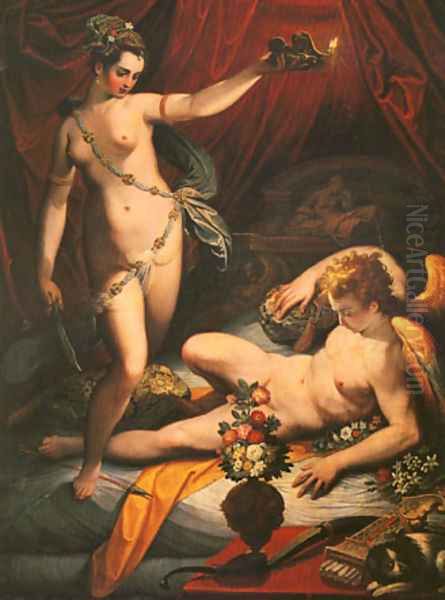
Zucchi's training with Vasari equipped him well for large-scale fresco projects. One of his most important decorative commissions in Rome was the gallery of the Palazzo Ruspoli (then Palazzo Rucellai). Here, he painted a series of frescoes depicting the "Genealogia dei Dei" (Genealogy of the Gods), a complex mythological program that transformed the space into a vibrant mythological universe. These frescoes, with their dynamic figures and intricate narratives, showcase Zucchi's mastery of illusionistic techniques and his ability to integrate painting with architecture. This project solidified his reputation in Rome as a skilled decorator in the grand Mannerist tradition, following in the footsteps of artists like Francesco Salviati and Taddeo Zuccari, who had undertaken similar ambitious fresco cycles in Roman palaces.
He also contributed to the decoration of several Roman churches, including Santo Spirito in Sassia, where he painted an altarpiece of "The Incredulity of Saint Thomas." This work demonstrates his ability to adapt his style to religious subjects, imbuing them with a sense of drama and spiritual intensity, albeit filtered through his characteristic Mannerist elegance. Another notable religious commission was the "Madonna of the Rosary" for the church of Santa Maria Novella in Florence, though this likely dates to his earlier period or was a commission he fulfilled from Rome. His work in San Silvestro al Quirinale also highlights his contributions to Roman ecclesiastical decoration.
Cabinet Pictures and Intimate Works
Beyond large-scale frescoes, Zucchi excelled in producing smaller, highly finished paintings, often on copper or panel, intended for private collectors. These "cabinet pictures" were prized for their exquisite detail, refined execution, and often esoteric subject matter. Works like "The Treasures of the Sea" (Galleria Borghese), also known as "The Coral Fishers," depict nude figures gathering coral and pearls, a theme that allowed for a display of graceful anatomy and a rich, decorative surface. The shimmering quality of the water, the polished skin of the figures, and the intricate rendering of shells and coral exemplify Zucchi's meticulous technique in these smaller formats.
His "The Toilet of Bathsheba" (Victoria and Albert Museum, London, though sometimes linked to Palazzo Barberini collections) is another example of his skill in depicting sensual female nudes within a rich narrative context. The attention to fabrics, jewelry, and the surrounding environment is typical of his decorative approach. Similarly, "Jupiter Fighting the Giants" (Metropolitan Museum of Art, New York) showcases his ability to handle dynamic, multi-figure compositions even on a relatively modest scale, capturing the mythological battle with energy and flair.
Collaborations and Artistic Milieu
Jacopo Zucchi's career was deeply intertwined with the collaborative workshop practices of the sixteenth century. His early work alongside Giorgio Vasari, Giovanni Stradano, and Giovanni Battista Naldini on projects like the Palazzo Vecchio decorations was fundamental. This collaborative environment was common, especially for large-scale commissions that required a team of artists with specialized skills working under a principal master.
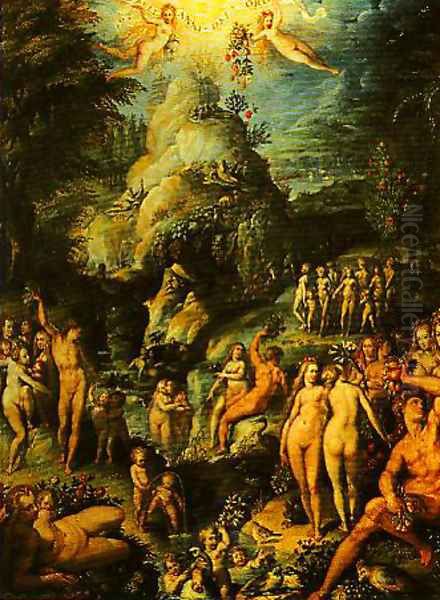
In Rome, while he established himself as an independent master, he continued to operate within a vibrant artistic community. He would have been aware of the work of his contemporaries, such as Scipione Pulzone, known for his strikingly realistic portraits, or Girolamo Siciolante da Sermoneta and Livio Agresti, who were also active in Roman churches and palaces. The legacy of High Renaissance masters like Raphael and Michelangelo, and earlier Mannerists like Perin del Vaga, was ever-present. Furthermore, the Zuccari brothers, Taddeo and Federico Zuccari, were dominant figures in Roman painting, undertaking vast decorative schemes, and their influence, particularly Federico's international Mannerist style, would have been part of the artistic discourse.
Zucchi's own brother, Francesco Zucchi (active 1562-1621), was also a painter and stuccoist, and they are known to have collaborated on some projects, particularly decorative ensembles that required both painted and sculptural elements. This familial collaboration was not uncommon in Renaissance workshops.
Anecdotes, Debates, and Art Historical Reception
Art historical scholarship has shed light on various aspects of Zucchi's career, including the nature of his patronage and the interpretation of his complex iconographies. The "Rucellai Gallery Dialogue," a text associated with the Palazzo Ruspoli decorations, offers insights into the intellectual context of such commissions, though its precise authorship and Zucchi's direct involvement in its writing remain subjects of discussion.
There has been some debate regarding Zucchi's continued relationship with the Medici after his move to Rome and the extent of Cardinal Ferdinando's patronage versus other commissions. While Ferdinando was undoubtedly a key patron, Zucchi also worked for other Roman families, such as the Capponi and Rucellai, indicating a broadening of his client base.
His stylistic fusion of Florentine disegno with a rich, decorative sensibility, sometimes showing affinities with Northern European art, has also been a point of interest for art historians. This blending of influences contributed to the distinctive character of his work within the broader spectrum of late Mannerism. The attribution and dating of some works have also been subject to scholarly debate, a common challenge in art history, particularly for artists who were part of large workshop systems or whose oeuvres are not exhaustively documented.
Later Years and Legacy
Jacopo Zucchi remained active in Rome until his death, which is generally placed around 1590. He successfully navigated the competitive artistic landscape of the city, securing prestigious commissions and establishing a reputation as a skilled and imaginative painter. His art represents a refined and sophisticated iteration of late Mannerism, characterized by its elegance, intellectual depth, and decorative appeal.
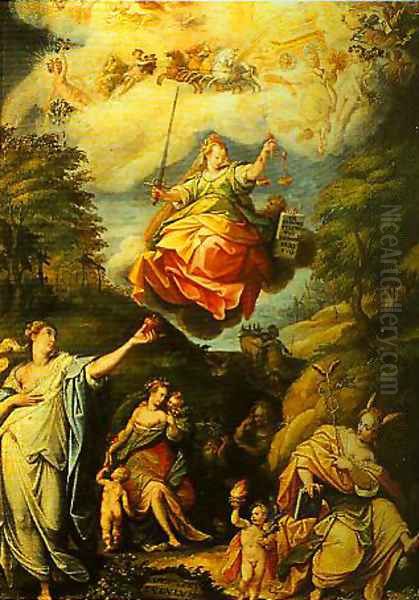
His influence can be seen in the continuation of Mannerist trends in Rome, even as new artistic currents, such as the burgeoning Baroque style championed by artists like Annibale Carracci and Caravaggio, began to emerge towards the end of the sixteenth century. Zucchi's dedication to complex allegories and mythological scenes, rendered with polished craftsmanship, catered to the tastes of an elite, educated clientele.
While perhaps not as widely known today as some of his High Renaissance predecessors or early Baroque successors, Jacopo Zucchi holds an important place in the history of Italian art. His work exemplifies the artistic ideals and intellectual preoccupations of the late sixteenth century, a period of transition and immense creativity. He was a master of the intricate and often esoteric visual language of Mannerism, an artist who could transform complex ideas into visually stunning and intellectually engaging works of art. His paintings and frescoes continue to be admired for their technical brilliance, imaginative power, and enduring beauty.
Notable Collections
Works by Jacopo Zucchi are housed in several prominent museums and collections around the world, as well as in situ in some Roman churches and palaces. Key institutions include:
Galleria Borghese, Rome: Holds several of his masterpieces, including "Amor and Psyche," "Allegory of the Creation," and "The Treasures of the Sea."
Uffizi Gallery, Florence: Possesses important works, including versions or studies related to "The Golden Age."
Palazzo Pitti, Florence: Also features works by the artist.
Victoria and Albert Museum, London: Houses "The Toilet of Bathsheba."
The Metropolitan Museum of Art, New York: Owns "Jupiter Fighting the Giants."
Palazzo Vecchio, Florence: His early collaborative works can be seen as part of the Studiolo of Francesco I.
Palazzo Ruspoli, Rome: His significant fresco cycle, the "Genealogia dei Dei," though access may be limited.
Churches in Rome: Such as Santo Spirito in Sassia and San Silvestro al Quirinale, contain examples of his religious art.
These collections provide opportunities to study and appreciate the diverse talents of this sophisticated Florentine Mannerist who made a significant mark on the artistic scene of Rome.
Conclusion: An Elegant Interpreter of a Complex Age
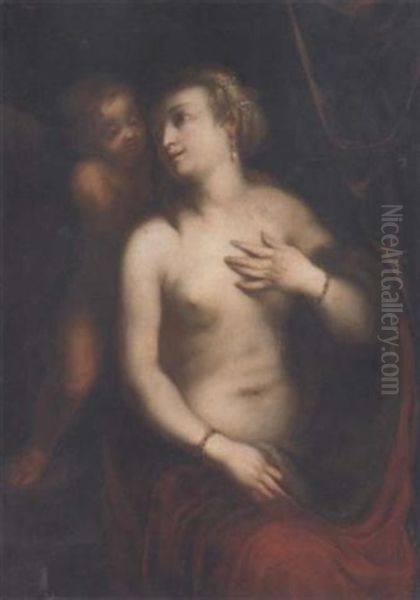
Jacopo Zucchi was a quintessential artist of his time, a product of the rigorous Florentine workshop system and a significant contributor to the rich artistic environment of late sixteenth-century Rome. As a favored painter of Cardinal Ferdinando de' Medici and other discerning patrons, he created works that were both visually sumptuous and intellectually stimulating. His mastery of complex allegories, his elegant figural style, and his decorative sensibility place him firmly within the Mannerist tradition, alongside contemporaries like Bronzino, Salviati, and members of Vasari's extensive circle.
His ability to translate intricate mythological and philosophical themes into compelling visual narratives, often on a grand scale in fresco or with jewel-like precision in cabinet pictures, speaks to his versatility and skill. From the collaborative efforts in the Palazzo Vecchio to his independent achievements in Roman palaces and churches, Zucchi's career reflects the dynamic interplay of patronage, artistic innovation, and intellectual currents that defined the late Renaissance. Though the artistic winds would soon shift towards the Baroque, Jacopo Zucchi's contributions remain a testament to the enduring allure and sophisticated elegance of Mannerism.